More sail trim tips from Chris Davidson and Chuck Skewes at Ullman Sails Seattle/San Diego.
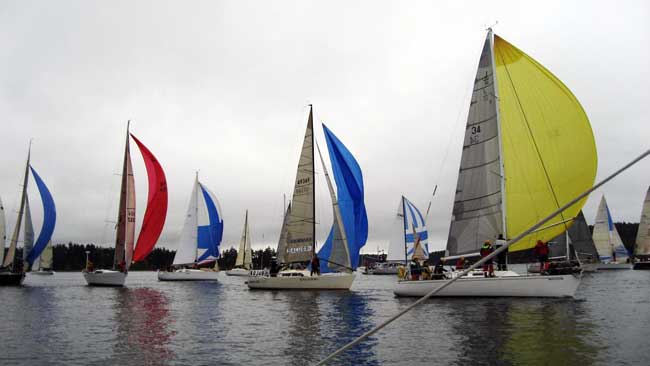
Photo by Tim O’Connell
Sailing downwind in light airs can be very challenging but some big gains can be made.
Weight should be distributed forward and grouped together. It is not uncommon for people to go below at this point. We would not recommend this approach unless you are on one gybe for an extended period of time as the time delay and the shaking of the boat when the crew has to move negates the gain of having them below.
Main trimmers can make the kite trimmers life much easier in these conditions. As well as trimming the main to maintain the optimum angle of attack between wind direction and sail they can also aid the kite trimmer when called for. When the trimmer is struggling the main trimmer can simply center the mainsail momentarily allowing the kite to re-fill.
The cunningham should be let off, the halyard eased to remove any vertical creasing in the luff and the backstay eased right off. The out-haul is something that causes debate amongst people as to whether you ease it off or leave it on hard as the area projected is slightly larger with the outhaul on. In reality i don’t have the scientific answer but I ease the outhaul slightly as it looks better and saves the sail from creasing. Vang tension should be adjusted to keep the top batten parallel with the boom. The top tell tale will stall if you use too much, not enough and the leech will spill too much power.
Tweakers are one of the most under utilized controls on a boat. Most people simply bang the windward one on and let the leeward one off. If however you adjust the pole height and the tweaker in conjunction the overall shape of the spinnaker can be affected making the sail drive more effectively or it can be flown higher opening the leeches and giving more lift.
Symmetric Spinnakers.
Pictured here are two yachts on a run in light airs.
 The white spinnaker boat has most of the crew out of the cockpit, bunched around the coach-roof. The blue spinnaker has everyone in the cockpit bar the bowman. We would like to see the weight on both boats centered around the shroud base.
The white spinnaker boat has most of the crew out of the cockpit, bunched around the coach-roof. The blue spinnaker has everyone in the cockpit bar the bowman. We would like to see the weight on both boats centered around the shroud base.
At first glance they appear to be set up pretty much the same.
Here we see the same boats but pictured from further ahead.
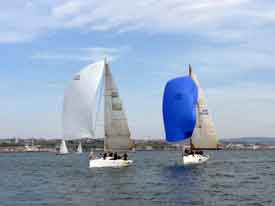 The blue spinnaker is clearly sailing lower than the white one. Sometimes this is tactical but often it is due to lag in instrumentation. Boat speed is king in these conditions. Sail for speed not on angle.
The blue spinnaker is clearly sailing lower than the white one. Sometimes this is tactical but often it is due to lag in instrumentation. Boat speed is king in these conditions. Sail for speed not on angle.
The blue sail is collapsing slightly as it is falling behind its own mainsail. This is a typical indicator of sailing too low.
Tactically the blue spinnaker needs to either sail a higher course or gybe so they can sail more effectively.
In the end the blue spinnaker could not continue to sail this low and was forced to sail up above the white in a bid to overtake.
This gives us a great view of the two boats set ups.
The blue spinnaker is set too high, a large proportion of its effort is being used to lift the sail rather than drive. Also the main has been simply eased all the way out rather than trimmed to suit the wind angle.
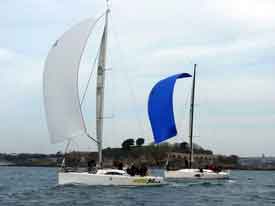 The white spinnaker in contrast has had the pole lowered and a small amount of tweaker applied to the sheet to force it to fly lower and convert more of its effort into forward motion.
The white spinnaker in contrast has had the pole lowered and a small amount of tweaker applied to the sheet to force it to fly lower and convert more of its effort into forward motion.
Tweakers and Telltales.
When running with Symmetric or Asymmetric spinnakers the tendency is always to keep easing the sheet and sailing lower.
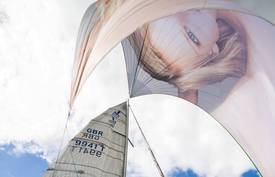 In the picture the sail is starting to fold down the centre line. This is caused by the sheet lead needing to be further forward. The solution is to use some tweaker (or twing).
In the picture the sail is starting to fold down the centre line. This is caused by the sheet lead needing to be further forward. The solution is to use some tweaker (or twing).
A good guide for this is to use telltales. These can be simply stuck on along each leech around 2 to 3 m apart on both sides of the sail. These telltales will help guide you on the amount of sheet required but also will indicate the sail opening more at the head then the rest of leach meaning you know to put the tweaker on or sheet in and sail higher.
Bringing it all together.
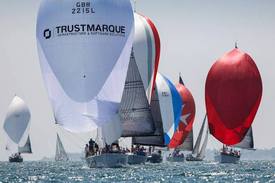 In this image we can see the pole and tweaker have been set to make the sail draw correctly.
In this image we can see the pole and tweaker have been set to make the sail draw correctly.
The crew weight has been brought forward and to windward giving the boat some windward heel.
Communication is the key to all of this happening. The sheet and guy trimmer need to work with the helmsman and main trimmer to continually adjust the boats course to maintain and improve boatspeed without sailing away from the mark. The tacticians role becomes less about dictating the direction of the boat and more about finding wind, keeping in clear air and planning the exit from the run onto the beat.